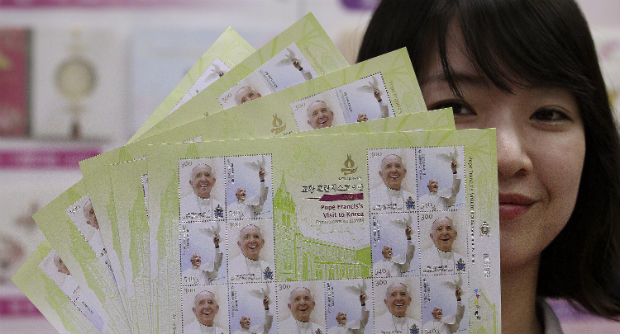
A worker at the Gwanghwamun Post Office unveils sheets of stamps to commemorate Pope Francis’ visit to South Korea in Seoul, South Korea, Thursday, Aug. 7, 2014. AP
SEOUL – When Pope Francis visits South Korea next week, he will find a thriving Catholic community with a social and political influence that belies its minority status in one of Christianity’s most muscular Asian strongholds.
The visit will recognize the vicious persecution of early Korean Catholics, with the beatification by Francis of 124 martyrs executed for their faith in the 18th and 19th centuries.
And the pope will also look to North Korea, where religion is subject to the tightest state control, when he offers a special mass for inter-Korean peace and reconciliation.
For many first-time visitors to Seoul, a common take-away memory is the surprising multitude of neon crosses glowing across the South Korean capital’s nightscape.
The theory that prosperity and socio-economic development tend to breed secularism holds little water in a country where modernity appears to have fuelled religiosity.
Korean Christianity is particularly pro-active and evangelical, sending more missionaries abroad than any other country apart from the United States.
In the last national census to include religious affiliation, conducted in 2005, close to 30 percent of South Koreans identified themselves as Christian, compared to 23 percent who cited the once-dominant Buddhism.
The majority are Protestants, but Catholics are the fastest-growing group, with around 5.3 million adherents – just over 10 percent of the population.
A minority with clout
As a minority, they punch well above their weight, with Catholics filling nearly 60, or 20 percent, of the 300 seats in the national parliament.
Of the six presidents elected in South Korea since the first free election in 1987, three were practicing Christians, including the Catholic Kim Dae-Jung.
Two others, Roh Moo-Hyun and current President Park Geun-Hye, were both baptized Catholics, but non-observant.
When Catholicism was first introduced to Korea in the 18th century, it was seen as subversive and barbaric by Confucian scholars, and its followers were brutally persecuted.
That period will provide a centerpiece for Pope Francis’s visit when he beatifies 124 Korean martyrs at a special open-air mass in central Seoul.
When Pope John Paul visited in 1984, he had canonized 103 martyrs – promptly elevating South Korea to number four in the list of countries with the most canonized Catholic saints, after Italy, Spain and France.
The real growth in the Catholic Church – and Christianity in general – coincided with the rapid urbanization that followed the drive to rebuild the country from the devastation of the 1950-53 Korean War.
Ripped out of their traditional social networks, the city newcomers looked for new communities and many found them in the Church.
Congregations swelled further in the wake of the Vatican II reforms which meant that mass could be said in Korean rather than Latin.
A champion of democracy
But perhaps the most significant growth motor was the active role the Catholic Church played in the pro-democracy struggle of the 1970s and 80s.
A number of Catholic leaders established themselves as human rights advocates, standing up to the military regime of the time under the threat of arrest and lengthy imprisonment.
“There’s no doubt that this helped enhance the image of the Church and helped attract new members,” said Don Baker, the director of the Centre for Korean Research at the University of British Columbia.
“It made it appear to be a Korean church, one that was concerned for Korean issues,” Baker told AFP.
Seoul’s Myeongdong Cathedral, where Pope Francis will conduct the reconciliation mass, was a focal point for the pro-democracy movement and was used as a place of sanctuary by many dissidents seeking to avoid arrest.
These days the focus is more on social issues, but there are progressive elements within the Church who still seek an active political role.
Late last year, the Catholic Priests’ Association for Justice (CPAJ) joined protests calling for President Park to resign over a scandal involving national intelligence agents who meddled in the 2012 presidential election.
The Protestant church has twice the membership, but has suffered in recent years from rifts between its various denominations, and scandals involving some of its wealthiest congregations.
“There’s been some disillusionment with some of the mega Protestant churches, particularly those where pastors pass control to their children,” said Bae Chul-Hyun, an expert on religious issues at Seoul National University.
“Catholicism in Korea has a comparably good image, and that has pushed membership,” Bae said.
By the late 1980s, the Catholic Church was held in such respect that joining began to be seen by some as a way of taking a step up the social ladder.
“I’m not sure if it would be accurate to say it is now seen as a religion primarily for the elite,” said Baker.
“But you can say it is a religion in which the elite can feel comfortable.”

